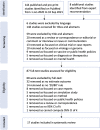Systematic review and meta-analyses of superspreading of SARS-CoV-2 infections
- PMID: 35799321
- PMCID: PMC9349569
- DOI: 10.1111/tbed.14655
Systematic review and meta-analyses of superspreading of SARS-CoV-2 infections
Abstract
Superspreading, or overdispersion in transmission, is a feature of SARS-CoV-2 transmission which results in surging epidemics and large clusters of infection. The dispersion parameter is a statistical parameter used to characterize and quantify heterogeneity. In the context of measuring transmissibility, it is analogous to measures of superspreading potential among populations by assuming that collective offspring distribution follows a negative-binomial distribution. We conducted a systematic review and meta-analysis on globally reported dispersion parameters of SARS-CoV-2 infection. All searches were carried out on 10 September 2021 in PubMed for articles published from 1 January 2020 to 10 September 2021. Multiple estimates of the dispersion parameter have been published for 17 studies, which could be related to where and when the data were obtained, in 8 countries (e.g. China, the United States, India, Indonesia, Israel, Japan, New Zealand and Singapore). High heterogeneity was reported among the included studies. The mean estimates of dispersion parameters range from 0.06 to 2.97 over eight countries, the pooled estimate was 0.55 (95% CI: 0.30, 0.79), with changing means over countries and decreasing slightly with the increasing reproduction number. The expected proportion of cases accounting for 80% of all transmissions is 19% (95% CrI: 7, 34) globally. The study location and method were found to be important drivers for diversity in estimates of dispersion parameters. While under high potential of superspreading, larger outbreaks could still occur with the import of the COVID-19 virus by traveling even when an epidemic seems to be under control.
Keywords: COVID-19; SARS-CoV-2; dispersion parameter; meta-analysis; superspreading; systematic review.
© 2022 Wiley-VCH GmbH.
Conflict of interest statement
BJC reports honoraria from AstraZeneca, Sanofi Pasteur, GSK, Moderna and Roche. The authors report no other potential conflict of interest.
Figures




Similar articles
-
Superspreading, overdispersion and their implications in the SARS-CoV-2 (COVID-19) pandemic: a systematic review and meta-analysis of the literature.BMC Public Health. 2023 May 30;23(1):1003. doi: 10.1186/s12889-023-15915-1. BMC Public Health. 2023. PMID: 37254143 Free PMC article.
-
A statistical framework for tracking the time-varying superspreading potential of COVID-19 epidemic.Epidemics. 2023 Mar;42:100670. doi: 10.1016/j.epidem.2023.100670. Epub 2023 Jan 24. Epidemics. 2023. PMID: 36709540 Free PMC article.
-
Differences in the superspreading potentials of COVID-19 across contact settings.BMC Infect Dis. 2022 Dec 12;22(1):936. doi: 10.1186/s12879-022-07928-9. BMC Infect Dis. 2022. PMID: 36510138 Free PMC article.
-
Superspreading potentials of SARS-CoV-2 Delta variants across different contact settings in Eastern China: A retrospective observational study.J Infect Public Health. 2023 May;16(5):689-696. doi: 10.1016/j.jiph.2023.02.024. Epub 2023 Mar 5. J Infect Public Health. 2023. PMID: 36934643 Free PMC article.
-
Superspreading and heterogeneity in transmission of SARS, MERS, and COVID-19: A systematic review.Comput Struct Biotechnol J. 2021;19:5039-5046. doi: 10.1016/j.csbj.2021.08.045. Epub 2021 Sep 1. Comput Struct Biotechnol J. 2021. PMID: 34484618 Free PMC article. Review.
Cited by
-
Estimating the reproduction number and transmission heterogeneity from the size distribution of clusters of identical pathogen sequences.Proc Natl Acad Sci U S A. 2024 Apr 9;121(15):e2305299121. doi: 10.1073/pnas.2305299121. Epub 2024 Apr 3. Proc Natl Acad Sci U S A. 2024. PMID: 38568971 Free PMC article.
-
Characterizing Human Collective Behaviors During COVID-19 - Hong Kong SAR, China, 2020.China CDC Wkly. 2023 Jan 27;5(4):71-75. doi: 10.46234/ccdcw2023.014. China CDC Wkly. 2023. PMID: 36777899 Free PMC article.
-
Exploring the role of superspreading events in SARS-CoV-2 outbreaks.J Theor Biol. 2023 Feb 7;558:111353. doi: 10.1016/j.jtbi.2022.111353. Epub 2022 Nov 14. J Theor Biol. 2023. PMID: 36396116 Free PMC article.
-
Superspreading, overdispersion and their implications in the SARS-CoV-2 (COVID-19) pandemic: a systematic review and meta-analysis of the literature.BMC Public Health. 2023 May 30;23(1):1003. doi: 10.1186/s12889-023-15915-1. BMC Public Health. 2023. PMID: 37254143 Free PMC article.
-
Genetic Predisposition to SARS-CoV-2 Infection: Cytokine Polymorphism and Disease Transmission within Households.Biology (Basel). 2023 Oct 30;12(11):1385. doi: 10.3390/biology12111385. Biology (Basel). 2023. PMID: 37997984 Free PMC article.
References
-
- Akhmetzhanov, A. R. , Jung, S. ‐M. , Cheng, H. ‐Y. , & Thompson, R. N. (2021). A hospital‐related outbreak of SARS‐CoV‐2 associated with variant Epsilon (B.1.429) in Taiwan: Transmission potential and outbreak containment under intensified contact tracing, January‐February 2021. International Journal of Infectious Diseases, 110, 15–20. - PMC - PubMed
-
- Bi, Q. , Wu, Y. , Mei, S. , Ye, C. , Zou, X. , Zhang, Z. , Liu, X. , Wei, L. , Truelove, S. A. , Zhang, T. , Gao, W. , Cheng, C. , Tang, X. , Wu, X. , Wu, Y. , Sun, B. , Huang, S. , Sun, Y. , Zhang, J. , … Feng, T. (2020). Epidemiology and transmission of COVID‐19 in 391 cases and 1286 of their close contacts in Shenzhen, China: A retrospective cohort study. The Lancet Infectious Diseases, 20, 911–919. - PMC - PubMed
-
- Chang, S. , Pierson, E. , Koh, P. W. , Gerardin, J. , Redbird, B. , Grusky, D. , & Leskovec, J. (2021). Mobility network models of COVID‐19 explain inequities and inform reopening. Nature, 589, 82–87. - PubMed
Publication types
MeSH terms
LinkOut - more resources
Full Text Sources
Medical
Miscellaneous

